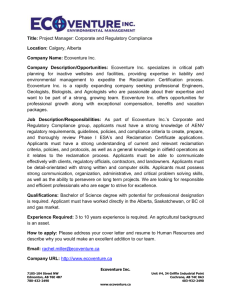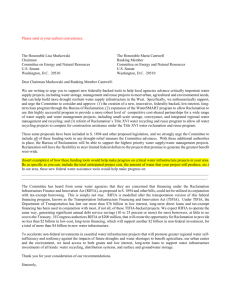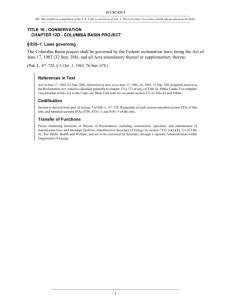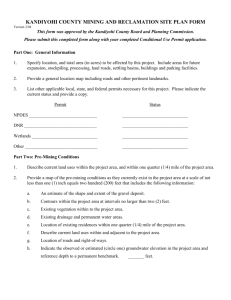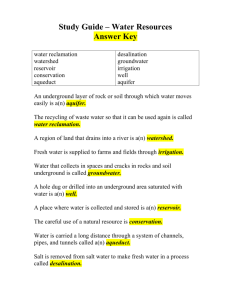IMPACT OF RECLAMATION ACTIVITIES ON THE ENVIRONMENT
advertisement
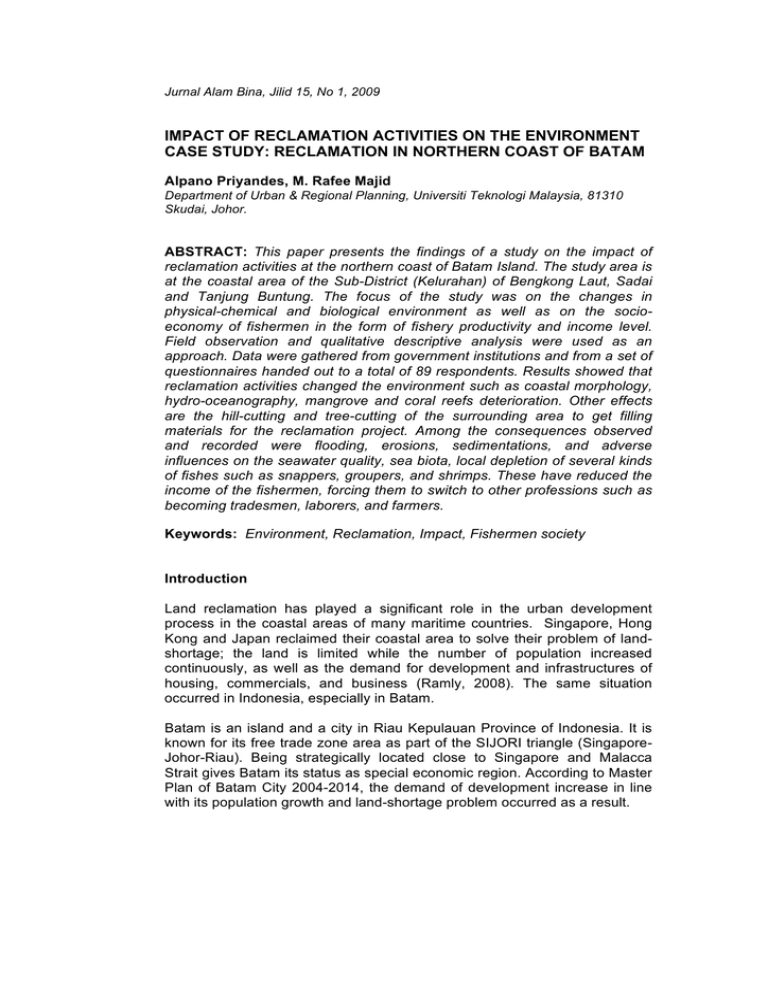
Jurnal Alam Bina, Jilid 15, No 1, 2009 IMPACT OF RECLAMATION ACTIVITIES ON THE ENVIRONMENT CASE STUDY: RECLAMATION IN NORTHERN COAST OF BATAM Alpano Priyandes, M. Rafee Majid Department of Urban & Regional Planning, Universiti Teknologi Malaysia, 81310 Skudai, Johor. ABSTRACT: This paper presents the findings of a study on the impact of reclamation activities at the northern coast of Batam Island. The study area is at the coastal area of the Sub-District (Kelurahan) of Bengkong Laut, Sadai and Tanjung Buntung. The focus of the study was on the changes in physical-chemical and biological environment as well as on the socioeconomy of fishermen in the form of fishery productivity and income level. Field observation and qualitative descriptive analysis were used as an approach. Data were gathered from government institutions and from a set of questionnaires handed out to a total of 89 respondents. Results showed that reclamation activities changed the environment such as coastal morphology, hydro-oceanography, mangrove and coral reefs deterioration. Other effects are the hill-cutting and tree-cutting of the surrounding area to get filling materials for the reclamation project. Among the consequences observed and recorded were flooding, erosions, sedimentations, and adverse influences on the seawater quality, sea biota, local depletion of several kinds of fishes such as snappers, groupers, and shrimps. These have reduced the income of the fishermen, forcing them to switch to other professions such as becoming tradesmen, laborers, and farmers. Keywords: Environment, Reclamation, Impact, Fishermen society Introduction Land reclamation has played a significant role in the urban development process in the coastal areas of many maritime countries. Singapore, Hong Kong and Japan reclaimed their coastal area to solve their problem of landshortage; the land is limited while the number of population increased continuously, as well as the demand for development and infrastructures of housing, commercials, and business (Ramly, 2008). The same situation occurred in Indonesia, especially in Batam. Batam is an island and a city in Riau Kepulauan Province of Indonesia. It is known for its free trade zone area as part of the SIJORI triangle (SingaporeJohor-Riau). Being strategically located close to Singapore and Malacca Strait gives Batam its status as special economic region. According to Master Plan of Batam City 2004-2014, the demand of development increase in line with its population growth and land-shortage problem occurred as a result. IMPACT OF RECLAMATION ACTIVITIES ON THE ENVIRONMENT CASE STUDY In the year of 2004, the local government of Batam City has approved a reclamation project in Bengkong District. The purpose of this project was to develop a kawasan terpadu (integrated area of housing, public facilities, services and tourism), and to improve the economical activities at the northern part of the island. The project was done by five real estate companies and developers, and the total area reclaimed is 1,400 Ha. Currently, despite the reclamation project is still in its finishing stage, some developments have already started in some parts of the reclaimed area. While developing the region, the government of Batam City has to give attention to the aspects of environment. According to Goodland (1995), a continuous development should consider three factors; environmental sustainability, economic sustainability, and social sustainability. The ongoing development in Batam is becoming a center of interest for the people and the environmentalists due to its requirements of special treatments to avoid any environmental damages. According to Bryant et al. (1998), Dahuri et al, (2001), WRI (2001) and Fortes (2001), reclamation would alter the condition and ecosystem of the coastal area. In general, reclamation activities would influence several aspects : 1. Natural morphology of the beach and coastal area. 2. Coastal biological resources, like fisheries and other coastal biota. 3. Sediment area in the reclaimed location. 4. Mangrove and reefs. Saenger (1983), Salim (1986), and Naamin (1990) stated that mangrove ecosystem plays several roles as follows : 1. Physical functions: To maintain the stability of coastal line, protect coastal area from abrasion and intrusion, and process the waste. 2. Biological functions: Nursery and spawning grounds for fishes, shrimps, and other water organisms, nesting ground for birds, and natural habitat for many kinds of biotics. 3. Economical functions: Mangroves make good firewood, salt processing instruments, embankments, and building materials. While Moberg and Folke (1999) in Cesar (2000) stated that coral reefs ecosystem play major role in providing renewable resources like fishes, shrimps, squids, and other biotas. Other positive influences of coral reefs ecosystem are as follows: Physical structure that protects the coast; Supporting habitat for the food chains; Nitrogen fixation; Tourist attraction. Coral Reefs Ecosystem is not considered as good when the living coral composition is 0 to 24.9%, moderate at 25-49.9%, good at 50 to 74.9%, and excellent at >75% (Gomez and Alcala, 1984). 22 Alpano Priyandes, M. Rafee Majid There is a need of further study in the effects of the reclamation activities at the northern coastal area of Batam related to environmental to avoid any potential negative influence. Based on the master plan of Batam year 20042014, the city would be stated as a national level industrial center and environmental-based (beach and marine) tourism center. The government of Batam City, based on the master plan, has the rights and duty to manage the environment, include avoiding negative influences of some development activities. Figure 1: Map of Reclamation Area in Northern of Batam Island Method The methods used in this study are qualitative method with explorative, comparative and correlation approach through three steps: data classifying, data interpretation, and descriptive analyses. Explorative approach was used to get the information about environmental and social condition of the fishermen’s society in the study area in details. This approach would enable the researcher to identify the effects and the problems occurred from the previously mentioned variables. 23 IMPACT OF RECLAMATION ACTIVITIES ON THE ENVIRONMENT CASE STUDY Comparative approach was used in order to compare the environmental and social condition of the fishermen’s societies before and after the reclamation, to indicate the changes occurred as effects of the reclamation activities. Comparative approach was used as well as to investigate the possibilities of any causal relationship between the deterioration of mangroves and coral reefs to the fishes and the socio-economic conditions of the fishermen society. It was done by applying cross-analysis technique on the result of the questionnaires. SPSS (Statistical Package for the Social Sciences) and Microsoft Excel were used to support the analysis process. Primary data collections were done in three Sub-Districts in the Districts of Bengkong: Bengkong Laut, Sadai, and Tanjung Buntung. The data collection methods are as follows : a. Field observation. This method was used in order to get the first hand information about the situation in the study area by observing environmental and social conditions. b. Questionnaires. This method has done to the villagers in the reclamation area by creating the list of questions related to the socio economic issues. The questionnaire was distributed to the villagers in the Districts of Bengkong, Nongsa and Batu Ampar, due to its being affected by the reclamation activities, and the total respondents are 89 which is used sampling method. c. In-depth interview to some stakeholders, such as Fishermen’s Organization of Batam Persatuan Masyarakat Tempatan, and Local Government of Batam City. Results and Discussions Reclamation activities at the coast of Sub-Districts Bengkong Laut, Sadai and Tanjung Buntung triggered some changes to the geomorphology and hydrology around that area. These changes included slope elevation, river sediment compositions, tidal patterns, wave patterns, abrasion and water management area. Figure 2: Reclamation activities changed the topography and bathymetry 24 Alpano Priyandes, M. Rafee Majid Figure 3: Map of Abrasion Location Result of the observation showed some impact along the reclamation coastal area. The tidal wave hit the shore harder than the shock absorbing mechanism by the sea floor prepared for. This situation led to the more intensive abrasion, and eventually showed that the coastal stability is in a poor condition. The reclamation activities in the study area reduced the function of the mangrove forest as a natural folder to hold the water excess due to the rain and the up-tide. Results of this study showed that before the reclamation activities started, the mangrove forest along the coast in the Sub-Districts of Bengkong Laut, Sadai and Tanjung Buntung were 24,000 m², while after the reclamation, the only mangrove forest left is as wide as 2,500 m². The loss is significant and worth to be worried about because almost 80% of the mangroves forest were exists currently has gone and loss. 25 IMPACT OF RECLAMATION ACTIVITIES ON THE ENVIRONMENT CASE STUDY Figure 4: Mangrove forests along the coastal area around the reclamation site (Source: Dinas Kelautan, Pertanian dan Kehutanan Kota Batam, 2009) Figure 5: Mangrove Distribution in Area Study Before and After Reclamation Physically, the loss of the mangrove forests gave a hard strike to the nearby society. The increase of the flooded area is one of the effects of the 26 Alpano Priyandes, M. Rafee Majid mangrove deterioration. When the up-tide is high and the wave is strong, fishermen’s houses along the shoreline would be flooded due to the increase of the water level. The strength of the tidal wave in the study area in December to January and June to July might reach 0.0 – 3.4 knot (Badan Meteorologi dan Geofisika Kota Batam, 2009). During the up-tide in windy seasons, flood as deep as 0.5 meters strikes the fishermen’s villages near the shoreline. Table 1: Number of Up-Tide Flood Incident at Bengkong Coastal Month/Year January February June August December Total 2003 2004 2005 2006 1 1 1 1 1 1 1 2 4 Source: Kecamatan Bengkong, 2008 2007 2 1 3 The deterioration of the mangrove ecosystems also put a downside to the nearby societies, because it was the reliable source of living for the nearby societies. Most of them use mangrove wood as charcoal, firewood, building materials, and traditional medications. Figure 6: The area that used to be a mangrove forest The developer did not only use the sea sand as the material. Instead, they cut the hills around the Districts of Bengkong and Batu Ampar. The process of cutting trees and hills left its traces in the form of highly erosive lines, which 27 IMPACT OF RECLAMATION ACTIVITIES ON THE ENVIRONMENT CASE STUDY highly affected sedimentation when the rainy season comes and increased the flooding point around Bengkong District. Hence, it affected the water quality around Bengkong Coastal. Figure 7: Hilly in Bengkong before Reclamation Project Figure 8: Hilly in Bengkong after Reclamation Project Figure 9: Cutting hilly resulted erosion and sedimentation 28 Alpano Priyandes, M. Rafee Majid Figure 10: The cutting of the hills in order to get the reclamation material. Table 2: Number of Flooding Point in Bengkong District 2002 2003 2004 Number of Flooding Point 1 1 3 2005 5 2006 8 2007 12 Years Location Bengkong Laut Bengkong Laut Bengkong Laut (1 point) and Sadai (1 point), Bengkong Laut (2 point), Sadai (1 point), and Bengkong Indah (1 point) Bengkong Laut (4 point), Sadai (3 point), and Bengkong Indah (1 point) Bengkong Laut (5 point), Sadai (3 point), Tanjung Buntung (3 point) and Bengkong Indah (1 point) Source: Kecamatan Bengkong, 2008 The activities had turned the seawater close to the shore muddy due to the hill cutting, dredging, filling activities or the overflow of the materials. Low 29 IMPACT OF RECLAMATION ACTIVITIES ON THE ENVIRONMENT CASE STUDY water quality affected the seawater biota around the area due to the downgrade of oxygen penetration to the water, this situation negatively affected the lives of the fishes and coral reef, because coral reef plays important role as spawning ground, feeding ground, and nursery ground to many coastal organisms. Table 3: Sea Water Quality around Bengkong, Batam Center, Tanjung Sengkuang and Nongsa Coastal (Tering Bay) Parameter Physicals Color Turbidity Suspension Solid Chemicals PH Salinity Dissolved Oxygen BOD COD Unit Guideline from Ministry of Environment 02/MenKLH/11/1988 Allowed Wanted Before Reclamation (2002) After Reclamation (2007) CU NTU mg/L < 50 > 30 < 80 < 30 >5 < 25 8 – 13 9.6 - 11 40 - 45 24 - 35 31 - 52 98 - 134 % mg/L mg/L mg/L 6-9 10 Natural >6 < 45 < 80 6.5 – 8.5 Natural >4 < 25 < 40 6.5 – 7.5 2.7 – 2.9 1.3 – 2.4 21.6 – 23.1 32.8 – 53.7 8.6 – 10.1 4.7 – 7.2 5.5 – 7.9 50.4 – 62.2 81 - 95 Source: Dinas Permukiman dan Prasarana Wilayah Provinsi Riau (2002), Kementerian Negara Lingkungan Hidup, and Badan Pengendalian Dampak Lingkungan Hidup Kota Batam (2008) In 2002, before the reclamation started, the living reefs in the area covered 25 - 41.35%, it shows that coral reefs in the respective period were in the level of moderate. In 2007, the percentage covered 0 - 23.24% that means it is not good (CRITC COREMAP II-LIPI, 2004 and Yuniarti, 2007). Figure 11: Dead corals around the reclamation area 30 Alpano Priyandes, M. Rafee Majid Figure 12: Map of Coral Reef Distribution in Study Area It affected the productivity of fishes around Bengkong Coastal area, because 55% of fishes have declined significantly in productivity. The most decline fish is Belanak that reached 70% (See figure: 14). Also the deterioration of coral reefs and water quality caused the extinction some species of fish such as Snapper, Grouper and Shrimp that have economic high value in market. Figure 13: Declining fish catch Deterioration of the coral reefs due to reclamation activities triggered major decrease to the socio-economic situation of the fishermen society. Before 31 IMPACT OF RECLAMATION ACTIVITIES ON THE ENVIRONMENT CASE STUDY reclamation, most of the fishermen were able to catch approximately 15 kg per day, and after reclamation, most of them were only able to catch approximately 5 kg per day. It showed that the average decrease of the catch exceeds to approximately 10 kg per day. Before reclamation the fishermen were able to get RM.667 to RM.833 (Rp.2.000.000 to Rp.2.500.000) in a month, after reclamation, they might are able to get RM.333 to RM.500 (Rp.1.000.000 to Rp.1.500.000) per month. Figure 14: Fishery production Loss of the fishermen’s catch led them to profession shifting and profession diversification in order to close the income gap before and after reclamation. Around 20% of the fishermen choose to shift to other professions. Fifty percent of the profession shifters chose to work as laborers, 45% started their trading business by opening seafood restaurants or fish shops, while the other 5% tried their luck in farming. Figure 15: Changing of profession by fishermen 32 Alpano Priyandes, M. Rafee Majid Conclusion The status of Batam City as a Free Trade Zone increased its pace in infrastructure development. Uncontrollable growth resulted as inefficient and ineffective land use. While sustainable development should concern about balance of the environment, social, and economical factor, the development of Batam City, especially in term of reclamation, seemed fail to fulfill the requirements. Since 2004, reclamation showed obvious effects towards the physicalchemical environment, biological environment, and social aspects in the area. Physical-chemical effects include the change of bathymetry at the waters around the reclamation area at the coast of the Sub-District of Bengkong Laut, Sadai and Tanjung Buntung due to the dredging and underwater mining in order to get the filling material. This change disturbed the coastal balance, and changed the current pattern, waves, quality of the water, and sediment transportation systems. Hill cutting had also done in order to get the filling extra material, where the activity led to erosions and sedimentations. The reclamation activity had also suspended the functions of mangrove forests. Thereby, the high up-tide during the windy season would flood the fishermen’s estate along the coast. The floods are as high as 0.5 m. Mangrove forests and coral reefs were deteriorated. While the biological functions of those two entities are important for the water organisms, the productivity of fisheries are decreasing and several kinds of fishes such as Snapper, Grouper, and Shrimp has extinction. This situation affected the fishermen society nearby, especially when their fish traps are replaced. Fishermen’s society could not utilize the compensation in a proper manner. The compensation funds were not sufficient, and below the expectations of the fishermen. Most of the fishermen switched their profession into traders and laborers. However, without experience and knowledge, it was difficult for them to adjust to their new way of life. As result, most of them were bankrupt and chose to do the fishing activities in other areas. References Bryant D, Burke L, McManus J and Spalding M. (1998). Reefs at Risk: A Map Based Indicator of Threats to the World’s Coral Reefs. World Resources Institute. Washington, D.C. 33 IMPACT OF RECLAMATION ACTIVITIES ON THE ENVIRONMENT CASE STUDY Cesar, H. (2000). Collected Essay on the Economics of Coral Reefs. Cordio Departemen Biology and Environmental Science, Kalmar University. Sweden. Dahuri R, Rais J, Ginting SP dan Sitepu MJ. (2001). Pengelolaan Sumberdaya Pesisir dan Lautan Secara Terpadu. PT. Pradnya Paramita. Jakarta. Fortes M. (2001). Loss of Seagrasses and Mangroves in Asia Pacific: Biting the Hand that Feeds. Paper presented at the global conference on “Oceans and Coasts at Rio+10”. UNESCO. December 3-7, 2001. Paris. Gomez, E.D. and A.C. Alcala. (1984). Survey of Philippine Coral Reefs Using Transect and Quadrate Techniques. In: Comparing Coral Reef Survey Methods. Report of Regional Unesco/ UNEP Workshop. Phuket Marine Biological Centre. Thailand. Goodland, R. (1995). The Concept of Environmental Sustainability, Annual Review of Ecological System, 26. Naamin, N. (1991). Penggunaan Hutan Mangrove untuk Budidaya Tambak Keuntungan dan Kerugian. Dalam Prosiding Seminar IV Ekosistem Hutan Mangrove MAB Indonesia. LIPI. Bandar Lampung. Ramly, S. (20080. Impact on the coastal areas of the Tanjung Tokong Land Reclamation Project, Penang, Malaysia, Effects on wave transformation, sediment transport, and coastal evolution. LTH, Lund University. Sweden. Saenger. (1983). Global Status of Mangrove ecosystem. IUCN Commission on Ecology Papers. No.3. 1983 Salim, E. (1986). Pengelolaan Hutan Mangrove Berwawasan Lingkungan: Makalah dalam Pidato Pengarahan Diskusi Panel Daya Guna dan Batas Lebar Jalur Hijau Mangrove. 27 February 1986. Ciloto. WRI. (2001). Pilot Analysis of Global Ecosystems. Coastal Ecosystems. WRI. Washington, D.C. 34

